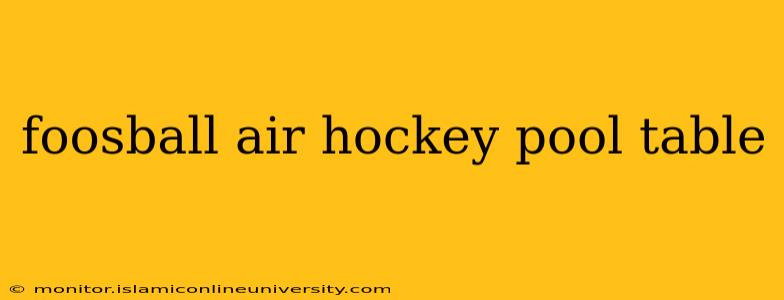Choosing between a foosball table, an air hockey table, and a pool table can be tough! Each offers a unique blend of skill, strategy, and social fun. This guide will break down the pros and cons of each game, helping you decide which—or perhaps which combination—best suits your game room dreams.
What are the differences between foosball, air hockey, and pool?
The core difference lies in the gameplay and skill sets required. Foosball emphasizes quick reflexes and precise rod manipulation, demanding dexterity and hand-eye coordination. Air hockey prioritizes speed, reaction time, and strategic puck control, rewarding aggressive play. Pool, on the other hand, blends precision, strategy, and a deep understanding of angles and spin, making it a game of both skill and finesse. The investment cost also varies significantly, with foosball tables generally being the most affordable, followed by air hockey, and pool tables being the most expensive.
Which game is best for different age groups?
Foosball: Foosball is accessible to a wide age range, from children to adults. Younger children might find it challenging initially, but with practice, they can quickly learn the basics. The relatively smaller playing area makes it easier for younger players to participate.
Air Hockey: Similar to foosball, air hockey is enjoyable across a wide age spectrum. The fast-paced action appeals to younger players, while the strategic elements keep adults engaged.
Pool: Pool requires a higher level of skill and patience. While children can play, they might find it frustrating initially. Adults often appreciate the strategic depth and challenging nature of the game.
What is the best game for a small space?
Foosball tables tend to have the smallest footprint compared to air hockey and pool tables, making them ideal for smaller game rooms or basements. Air hockey tables also come in various sizes, allowing for some flexibility depending on your available space. Pool tables, however, require considerably more floor space and headroom.
How much space do I need for each table?
The space requirements vary greatly depending on the table's size. Always check the manufacturer's specifications before purchasing. But generally:
- Foosball: Requires minimum clearance around the table for comfortable play.
- Air Hockey: Needs slightly more space than foosball, allowing for movement and puck retrieval.
- Pool: Demands a significant amount of space, including room for the cue stick swing and player movement. You'll need at least a couple of feet of clearance on all sides.
Which game is easiest to learn?
Foosball generally has the easiest learning curve. The basic gameplay is straightforward, although mastering advanced techniques takes time. Air hockey is also relatively easy to learn the basics, but developing sophisticated strategies takes practice. Pool has the steepest learning curve, requiring time and dedication to master the nuances of shot angles, spin, and bank shots.
Which game is the most challenging?
While all three games offer challenges, pool is often considered the most challenging, due to its strategic complexity and the precision required for accurate shots. Mastering pool takes significant practice and a deep understanding of physics and angles.
What's the best game for parties?
All three games are great for parties, but each offers a different dynamic. Foosball is quick to learn and easy to jump into, making it ideal for large groups. Air hockey provides fast-paced, exciting gameplay. Pool, while more challenging, can create a lively and competitive atmosphere. The best choice depends on your guests' preferences and experience levels.
Choosing between foosball, air hockey, and pool depends entirely on your personal preferences, available space, and budget. Consider the gameplay style, skill level, and space requirements to make the best decision for your game room!
